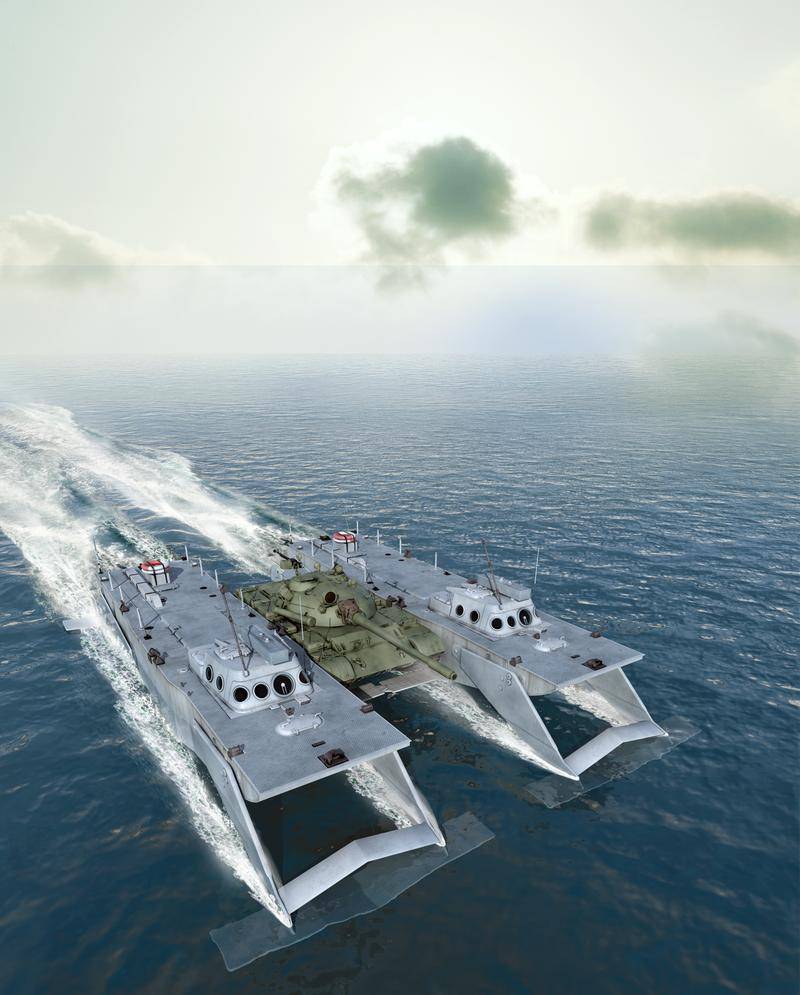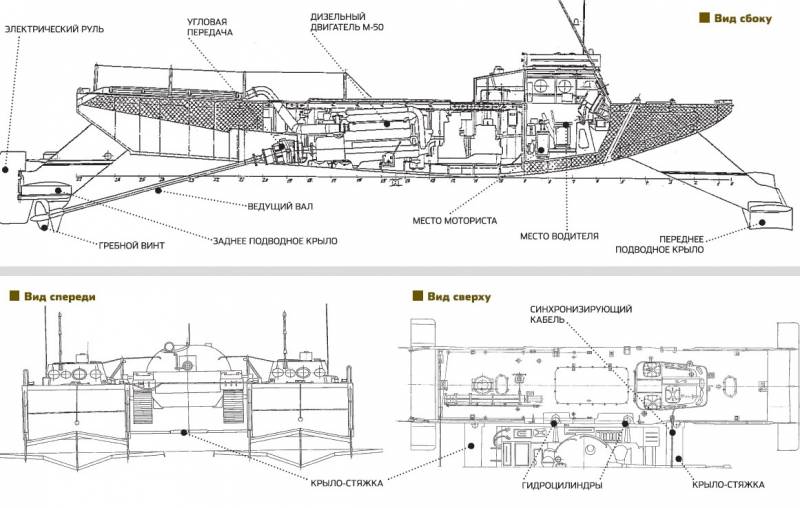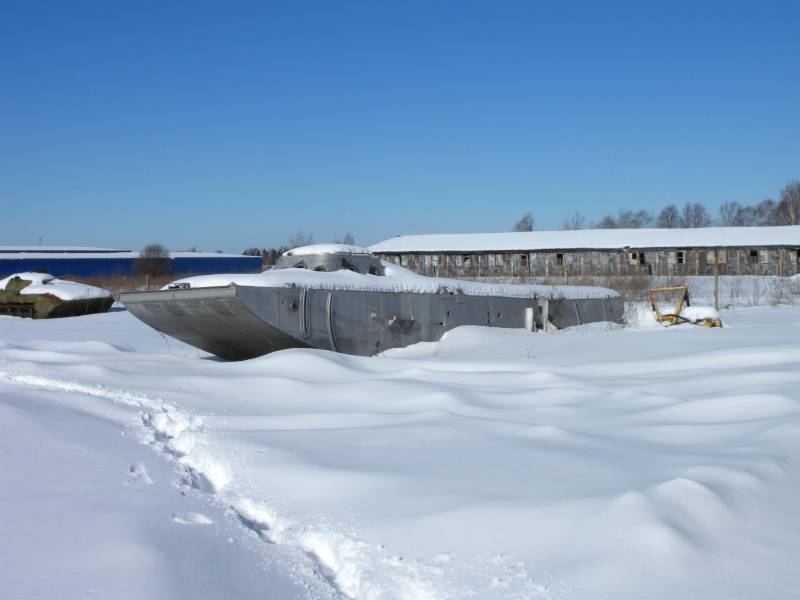Hydrofoil Tank: The Famous Soviet Project
Employees of the Vympel design bureau (at that time, the Volgobaltsudoproekt design bureau) and the Navashinsky shipbuilding plant, now deserved engineers, and then young designers and mechanics, told us about the device of the sea-speed tank landing craft of the 80 project. We obtained the technical data in the once-secret archives of the Vimpel design bureau. Only one question remained unanswered: who and for what purposes needed a hydrofoil tank, able to overtake any moving object on the water?
Transformer pontoon
This question could be addressed to Colonel Murgalev, who was the technical task and was the first military curator of the project. Pavel Mikhailovich Murgalev - a legendary person. It was he who invented the mine trawl for the T-34 tank, which was put into service in the 1942 year and went through the entire Second World War. The TK for a high-speed tank landing craft provided for the ability to quickly take on the T-54 tank (later T-55), speed above 50 km / h and high seaworthiness, in particular, the ability to move in waves to five points. An important and perhaps the most difficult requirement was the ability to fire directly from the water.
The development of the craft began at the end of the 1950s. A tank pontoon equipped with its own engine and hydrofoil was designed at the Volgobaltsudoproekt design bureau under the direction of Mikhail Shchukin. The wings were developed at the Central Design Bureau for hydrofoil vessels of the Krasnoye Sormovo plant (now the Central Design Bureau for the SEC named after RE Alekseev) - in the same place where the high-speed motor ships Rocket and Meteor were born. The unit also received the engine from the "Rocket" - the diesel M-50, capable of developing peak power 1200 hp.

Sea speed tank amphibious craft "project 80"
A set of high-speed tank landing craft consisted of two boats. Like ordinary non-motorized pontoons, they were mounted on the sides of the tank, equipped with special eyes. Each boat had two hydraulic cylinders, with the help of which the boats were raised above the ground. In this position, the tank entered the water to a certain precipitation.
In the transport position, the hydrofoils on the boats were raised and rather resembled the wings of a racing car. The tie-wings in front and behind the tank were raised and pressed to the board. Upon reaching the displacement position, the halves of the buckles were lowered and latched, forming rigid transverse crossbars at the level of the bottom of the craft. Thanks to the screeds, the boats could carry the tank without diverging to the sides. In the next instant, the hydraulic cylinders were already raising the tank above the water level and the pontoons began to displace.
The propeller and steering column of the boat were combined with the rear hydrofoil, so the depth of the propeller could be adjusted. The watercraft departed to a depth in the displacement position, then the hydrofoils dropped completely. The transverse screeds, submerged even in a displacing position, also had a wing profile and helped the boats to rise above the water surface.
It is important that the attachment of boats to the tank, and the closing of the wing-screed took place with the help of hydraulics and did not require manual labor. The complete acquisition of the craft before launching the water took 45 minutes, and the tank could get rid of the pontoons, coming ashore, in just a minute 3.
On the boats of the “80 project”, low-fledged hydrofoils of Rostislav Alekseev's construction were installed. They provide high hydrodynamic quality and low draft, and therefore - high speed. The main drawback of such wings is that they are contraindicated for strong agitation.
Life just a moment
By 1966, a model of hydrofoil boats on the scale of 1: 2, which was tested on the modest river Teshe, was made at Navashino Shipyard. And next year, a full-sized prototype went to the big water - in Sevastopol. “The crew of each car was small, only two people — the driver and the mechanic,” says the leading specialist of the Navashinsky plant, Valentin Borisovich Galin, “and one driver could control both his own boat and the watercraft as a whole. Steering and engines were controlled by electric motors and synchronized via cable. ”
On the water, the watercraft of the “80 project” immediately exceeded the design speed, speeding up to 58 km / h. But with the strength of the design problems. During one of the tests the screed broke. Boats parted, and the tank went under water. By that time, the device had not yet had time to go deep, so neither the crew nor the tank itself was damaged. To investigate the incident, a group of specialists from Volgobaltsudoproekt was sent to Sevastopol. “We stuck a lot of sensors on the tie-wings, fixed them with epoxy resin, connected them to the control equipment in a specially installed wheelhouse and went to sea,” says Pavel Semenovich Karpov, who worked as a designer of the 1 category in the strength sector. “As a result, we managed to find out that in the zone of maximum stress concentration on the wing there was a propylene groove, which became the cause of the rupture.”
Not quite smooth and it was with seaworthiness. Yes, the apparatus could move through the water with an excitement of up to five points, but only in a displacement position, with a corresponding low speed. Float on the hydrofoil could float at the excitement of not more than three points. When trying to storm the turbulent sea in full swing, the pontoons literally dived into the wave. The water got into the air intakes of the engines, and the diesels stalled. As a rule, after stopping the engines could quickly start again. During one of the tests, the lives of the crew members of the pontoon were threatened: the air intake hatch closed and the engine quickly began to evacuate the air from the interior. Fortunately, the mechanic guessed it in time to cut off the fuel supply and shut off the engine.
In the transport position, underwater wings, steering columns, propeller and tie-wings rose up. On land, the hydraulic cylinders lifted the boat above the ground, allowing the tank to move
The task, which initially could be considered impossible, was firing from the water. The tank sight for this type of shooting is not designed. Shooting from a moving ship at coastal targets requires completely different guidance systems and stabilizing devices. The shock wave generated during the shot exerts a tremendous dynamic load on the nodes of the pontoons themselves and on the mechanisms of fastening them to the tank. Needless to say about the threat to the health of the crews of unfortified aluminum boats ...
It should be noted that such impressive shots of the PT-76 tanks emerging from the hold of the amphibious assault ship are just a spectacular window dressing: the shooting is idle with reduced by more than half the powder charges. This is despite the fact that the caliber there is only 76 mm (against the 100 mm at the T-54 / 55), and the tank is initially floating. Still, shooting tests on the go as part of the “80 project” were carried out. Of course, they were not crowned with success.
The problem was the angular transmission of the drive shaft - the one that allowed the propeller to rise out of the water along with the hydrofoil. The complex knot could not withstand the loads, and every now and then it had to be redone. And yet the designers managed to bring the car to mind. At shipyards in Navashino, Rybinsk, Astrakhan, 13 sets of high-speed tank landing craft of the “80 project” were built. The experimental battalion of winged tanks was based in Sevastopol. It was rumored that some of the cars went to the Baltic. And in 1971, the project was closed. Why - none of our current consultants could answer. True, it is not difficult to guess.
Fly to the Bosphorus
The autonomy of the high-speed watercraft of the “80 project” was 350 km. 350 km by water is not at all the same as 350 km by road, at least for reasons of maritime navigation. A qualified navigator is vital for sea trips, and only the driver and the mechanic were placed on pontoon boats.
On the Black Sea, the days when the excitement does not exceed three points at a distance of 10 km from the coast, occur on the strength of three or four times a month. Therefore, the same "Rockets" and "Meteors" ply there only in the coastal zone. Taking into account the location of the experimental battalions, the floating facilities of the “80 project” were intended to quickly capture the shores of the Baltic straits and the Bosporus. And at the forefront was put not so much speed as the suddenness of the appearance of an unusual transport. In the case of the Bosphorus, tanks would have to overcome banks (shallow water lines running parallel to the coast at a distance of 5 − 10 km from it) and land on a rocky steep coast.
Ferry instead of tank
The boats of the “80 project” could be used in the configuration of a cargo ferry for transporting tanks that are not equipped with a special fastening system, as well as other land vehicles. For this purpose, a special cargo pontoon was attached to their hydraulic cylinders, on which a tank was installed across the course. In order to transport the vehicle could call on the ferry and leave it, four lifting tracks or two lifting ramps were provided. For lifting cargo, the steam was equipped with two crane beams.
In the technical data kindly provided by Vympel, the mass of boats of the “80 project” is modestly silent. With 350 km autonomy, the device must carry fuel for at least seven hours of travel. The engine of each pontoon develops power 1200 hp, whereas the ship “Comet” “horses” of all 900. Consequently, the fuel consumption of the “80 project” is greater than the kg / h 400 — on the order of kg / h 600. At seven o'clock it takes 2,8 − 3 tons of fuel in each boat. The ponton of the PMP fleet transported on the Kraz-255 weighs 8,5 tons. We venture to suggest that the boat of the “80 project” with fuel, engine, transmission and wings weighs no less than 15 tons. This is indirectly confirmed by the fact that it does not load onto the Kraz-255 , and towed on special trailer.
In order for a tank to carry two 15-ton boats, it must be fitted with mounting hardware, the weight of which, according to modest estimates, will be 2 − 5% of the mass of the tank itself. This is about a ton of dead metal, which the tank may need only once, but which it should carry with it always.
The suspension of the tank is not designed for such loads: it is believed that even the weight of the KMT-6 knife trawl (800 kg) leads to the rapid destruction of the front roller bearings. If the undercarriage is designed for the extra weight of the 30 − 40 t, then, freeing itself from ships after getting out of the water, the tank will have a too rigid suspension, which will lead to a complete loss of its shock-absorbing properties. The tank will not be able to move normally over land and fire.
The ground pressure of the tracks of the T-54 tank (T-55, T-62) is of the order of 0,78 kg / cm2. With suspended pontoons, it will increase to 1,5 − 1,8 kg / cm2. Tanks with the largest ground pressure in the world (German PzKpfw VI “Tiger”) with a pressure of just 1,04 kg / cm2 in the morning on 5 on July 1943 failed to attack, and waited for 8 hours at night softened up. If we take into account that the bottom soil near the coast does not differ in density and usually withstands a specific pressure of no more than 0,5 − 0,64 kg / cm2, then it is clear that, once at the coast, a tank with mounted boats cannot get out of the water.
No tank in the field
Yet the main problems of the “80 project” are tactical. The landing operation involves the simultaneous participation of several hundred or at least dozens of ships moving on a strict schedule. Tanks, infantry, artillery, sappers, and means of support should land in a certain order on the shore. By the time the battalion of the “80 project” approaches the coast, it should be covered with naval artillery fire. For conventional landing craft, this issue is solved simply - part of the artillery is on the landing craft themselves, part on the ships of the artillery support, which move along with the landing craft. And what about the "project 80"? Artillery support vessels will not be able to accompany such a battalion, since their speed is two to three times lower. It means that they should move to the place of landing earlier. And in this case, the very meaning of speeding the landing of tanks is lost: the enemy, having seen the ships of the artillery support, will be ready to meet the "winged tanks" with fire.
What are tanks without infantry, without artillery, without sappers, without ammunition? Ammunition is enough for 30 minutes of battle, if before that the tanks do not burn the enemy's grenade launchers. Perhaps the tank on a hydrofoil could have unexpectedly approached the combat zone as reinforcement, having landed a little distance away on the unguarded part of the coast. But, you see, this is a very modest role for such an ambitious project.
The creators of the "project-80" focused on solving one very narrow task - the creation of a watercraft capable of transporting a tank by water at high speed. They left out of sight many technical and tactical issues, which ultimately led to the collapse of the project. Of course, the war has its own laws. Nevertheless, the “80 project” is a stunningly elegant and perfect work of Soviet engineering, which, unfortunately, is destined to be forgotten. Together with the people who happened to see the boats with their own eyes, the cars themselves also die. The last "preserved" pontoon, or rather its body, is kept in a closed fund of the Museum of Armored Forces in Kubinka. With all the desire of the museum staff to restore it will not succeed: all attachments machines, including wings and screeds, irretrievably lost. After all, the boats of the “80 project” were made of high-quality and expensive aluminum.



Information